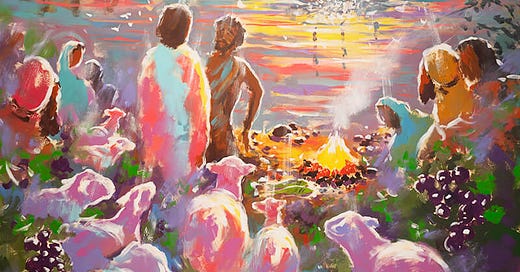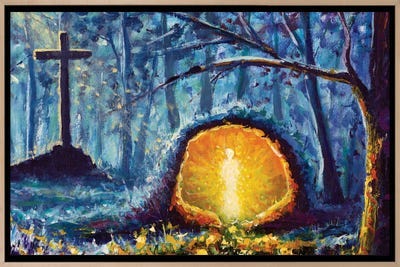Alleluia! Christ is Risen!
And I’m (maybe) an upright and functional person again following my parish’s Sensory Stations of the Cross and an Easter Egg hunt in high winds. At least it wasn’t snowing! (My town did get 4 inches of snow the day before Palm Sunday – I was getting a little worried.)
So, how are we rejoicing for the rest of this bright and glorious Easter season? What are you creating in this time of new life?
A New Way
I find myself feeling very tender about the fact that we call the core Eastertide story in Godly Play “Knowing Jesus in a New Way.” (And if you haven’t seen the new art, you definitely need to check it out! It’s gorgeous and illustrated by Elena Selivanova, who worked on Glenys Nellist’s beloved ‘Twas the… series.) The way this captures both the way Jesus is still with us and everything we cannot know about the mysteries of his embodied, resurrected form speaks to me, particularly in the presence of his woundedness.
I miss Thomas Sunday because I take the week after Easter off from writing, but oh! As someone shaped by Nancy Eisland’s The Disabled God,1 knowing that resurrection can also sustain brokenness is so essential to my own faith. About ten years ago, I told my EfM group – a room where everyone had at least three decades on me and, as a result, I think had some notions about what my embodied and cognitive life was like – that I intended to take my depression to heaven, they were somewhat appalled. Their conceptions of wholeness were different from mine. My personhood, what I envisioned as my resurrected integrity, included my brokenness.
As I have become more disabled, I think I envision both leaving my chronic pain behind and keeping so many of the other body’s particularities, even if they might be considered “wrong” by the world. Wounds. Stigmata. The resurrected Christ was broken and whole all at once. And when the disciples encountered him during this time, that was part of how they came to know him.
So when we say that Easter is about being a new creation, that we are learning to know Jesus in a new way, How do we understand that? Maybe it starts by seeing ourselves and our communities in new ways.
Feed My Sheep
By the time we reach this Sunday’s lectionary reading, in which Jesus shares breakfast on the beach with his disciples, they have begun to understand this “new way.” They have begun to recognize Jesus’s new form, having met with him in the Upper Room
It is in this place of new knowing, of beginning to reimagine, that Jesus asks Simon Peter to feed his sheep. The Good Shepherd needs others to come after him. It’s what we’re asked to do, too. And we are asked to know all of those sheep, each in its own way with its own needs. Maybe those sheep are your children, your immediate family, their classmates. Maybe those sheep are all of the young people at a big city church, dozens and dozens on any given Sunday. Maybe you’re a classroom teacher at a public school or a social worker. Maybe you’re something else entirely – but you know who your sheep are.
Many of us are looking toward the end of our program year, preparing for our own seasonal change, the time when it can be harder to care for our sheep as they disperse on their own adventures. We’ll get reoriented to these weeks of Easter and then we’ll talk about summer in the next few weeks. (With apologies to my loyal reader Mike who may be the only person reading this from the Southern Hemisphere!)
A Prayer
Risen Lord, you walked among us, displaying what the world can do to break a body. Help us to use our own imperfect selves in the tending of your sheep, knowing that this is one way we can live our love for you – by loving each other well. Amen.
Resource Round-Up
What’s new since before Easter? Let’s see!
Roots & Wings will be presenting insights from a recent literature review on intergenerational formation during a May 29th webinar.
A few days late, but I wrote about Saint Zita of Tuscany for Grow Christians. I fielded a lot of questions about the relationship between the Episcopal Church and saints more generally. I think the particular nature of the miracles associated with Zita help us to see the trends in miracles and the way influence spread both between holy figures, as well as how we use saints as models for how to live rather than intercessors between us and God.
The Godly Play “Spirituality of the Child” session is one of the most powerful items in my own toolbox and Everyday Godly Play will be offering a special webinar on this topic on May 15 for clergy and religious educators. Find out more here!
Creation Care is one of the most pressing topics for young people in the Church today and climate change has produced a new existential limit. Catch a great new blog post over at Illustrated Ministry about Why Christians should care about Ecojustice. How can this area of concern shape your ministry? For more, check out the new book “A Kid’s Guide to Saving the World: It’s Not Hopeless and We’re Not Helpless” by Paul Douglas.
This coming Saturday is World Labyrinth Day! Whether you have a nearby labyrinth or create your own at home, spend some time considering how labyrinths fit into your practice of prayer, as well as our greater lineage as people who make pilgrimages as part of our faith lives.
It’s good to be back, friends! And, a small note of celebration as we sign off: Wiggles & Wonder has hit 400 subscribers. Thank you for being on this journey with me!
Peace,
Bird
“The Disabled God: Toward a Liberatory Theology of Disability” by Nancy Eisland, Abingdon Press, 1994





